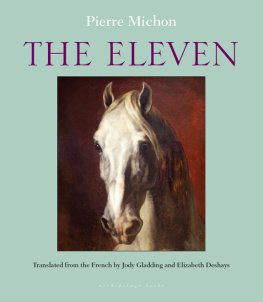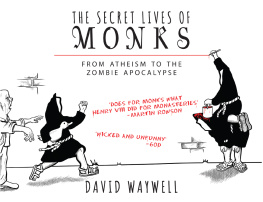Pierre Michon
Winter Mythologies and Abbots
Pierre Michon was born in 1945. He made his name with his first published work, Vies minuscules (Small Lives), which appeared in 1984, when he was thirty-nine. He is one of the finest and most admired French writers of today, and he has received recognition in the form of the Prix Dcembre for Abbots and Corps du roi (The Kings Body; a collection of short literary essays) in 2002, and the Grand Prix du Roman de lAcadmie franaise for his novel Les Onze (The Eleven) in 2009. Another novel is in preparation, and he lives in Nantes.
Small Lives may have represented a late start for Michon, but it provided him with a theme on which a number of fruitful variations were to follow. Michons preferred subjects are small in the sense of obscure or apparently insignificant, and his preferred form is small in the sense of short. Small Lives tells the stories of eight figures from Michons own background in Creuse, part of the relatively poor and rural Limousin region, who positively or negatively shaped the vocation which, when finally realized, enabled him to restore them to life through his writing. The figures who populate Winter Mythologies and Abbots are for the most part equally obscure, though historically more distant: minor saints and little-known monks from the early Middle Ages in the French and Irish provinces. The brevity of the texts in which they appear gives readers the sense of merely glimpsing critical moments in these unfamiliar lives which often include or anticipate their end.
The origins of these tales lie in archives rather than in autobiographical experience or family legend, and although the pretext for writing them was for the most part a commission of some kind, Michon is at home in occasional pieces. The Alliance Franaise of Ireland commissioned the three texts which make up the first part of Winter Mythologies (1997); a writers residency in the Vende region was the basis for the trilogy of Abbots. Much of the material for Nine Passages on the Causses owes its origin to the chance find, in a village shop in Sainte-nimie or Marjevols in the Causses region, of a reprint of a history of the Gvaudan first published in 1925. The two villages are themselves commemorated in the writing that resulted. Some of the sources are explicitly acknowledged, as they are in the opening sentence of each of the tales in Abbots or the references to the Annals of the Four Masters, while others, such as Gaston Phoebuss fourteenth-century treatise on the art of hunting, are more obliquely cited.
Michons great theme is the precarious balance between belief and imposture, and the way the greatest aspirations can be complicated by physical desire or the equally urgent desire for what he calls glory. Brigids fervor is as sexual as it is spiritual, but no less cogent for all that. bles monastery is founded as much on his desire to survive in the memory of men and on the blood that results from his sexual jealousy as it is on his religious convictions. Michons abbots are politically savvy and skilled in manipulation. douard Martels speleology and his discovery of some of the largest underground caves in France are portrayed as the direct result of personal ambition. Eloquence is born of an unfounded faith in a stolen relic which proves to be a fake. But faith can also be lost, as Michons believers abruptly succumb to doubt, despair, or a destructive impulse that might, or might not, be the work of the devil.
The forms taken by religious belief in the Middle Ages may leave the modern reader incredulous, but the mix of ill-foundedness and spiritual ardor, conviction and ambition, are for Michon what makes literature possible in a secular world. Many of his monks and both his nineteenth-century positivists are writers: Martel ultimately creates his caves by naming their stalagmites and describing their size; Barthlmy Prunires draws as much satisfaction from the words with which he records his finds as he does from the discoveries themselves. Simon summons nimie into being by instructing one of his monks to find written proof of her existence, and she is recalled to life once more when Bertran is commissioned to fabricate her legend. But to do so with his own kind of fictional truth.
Michon himself does nothing less. His characters derive their being partly from connections with Michons own experience: his acquaintance with the places where they live, fatherhood, or the play with the name Pierre, the author of the chronicle from which Michon takes much of his material for the trilogy. Just as important, like nimie in Bertrans octosyllabic poem, his characters also derive much of their being from the language he uses. Michons is a language that is unequivocally prose, in which a colloquial sarcasm and his own passing commentary can often be heard. But it also has a powerful poetic component. This is first and foremost a matter of rhythm. His sentences are syntactically simple and often slightly elliptical, creating an impression of speed and abruptness or suggesting origins in ancient chronicles. Michon himself has said that this style is actually the result of his switch from pen to computer for composition. Then there is the poetry that Michon conjures out of proper names whether Celtic, medieval, or those of the islands off the Vende coast (La Dune, Grues, La Dive, Elle) which speak in the original French of dunes, cranes, divinity, and a woman. There is poetry too in the rituals of religion or hunting, not to mention the Bible. The apparently incidental repetition of words and motifs creates a pattern that knits the small lives together as the devil and doubt come and go, figures are sliced in two through a variety of means, or the name Hugues settles on a number of awkward, fervent characters whose throbbing voice may be that of literature itself as it speaks in Michons compelling miniatures.
Ann Jefferson
We know from the teaching of the Lotus Stra That the Bay of Naniwa in the province of Tsu Is real too.
JIEN, Tendai school, 12th century
Three Miracles in Ireland
Muirchu the monk relates that Leary, king of Leinster, has three sweet young daughters. Brigid is the eldest. About the two others, the monk has knowledge only of their youth and their sweetness, not their names. Three young girls. It is daybreak in April in Dn Loaghaire, a town of wood and peat, which broods under the rule of a fortified clod. Its a royal town. The king is widowed and powerful, he is sleeping; he has thrown off his covers in the murky sleep of dawn. Brigid, who is awake, can see the river through the window under the first rays of the sun. Shes a wise girl whose custom is to ask her father only for what her father cannot refuse her. She slips into the kings chamber, and before she sees that he is naked she has gently placed her hand on his shoulder. At her touch the king has a dream which agitates him the way a woman might. Brigid sees his agitation. He wakes. They look at each other like strangers, or husband and wife. Blushing, she asks his permission to bathe in the river with her sisters. He blushes and gives his consent.
All three girls run through the spring dawn. They reach the bottom of the embankment and throw their clothes under the foliage. Their little feet taste the water, and above their little feet their milk-white rust-spotted flesh is naked a hundred times over, the flesh of Ireland and of paganism. For the first time Brigid sees that this flesh is excessive, like a dreaming king. She laughs louder than her sisters. All three shriek when the cold bites their bellies; they slap the water with the palms of their hands, the birds fly up, and the hullabaloo reaches the road above.











